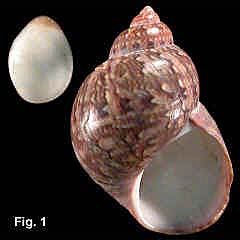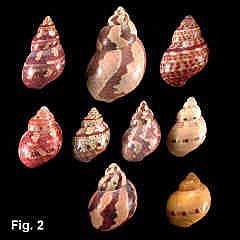|
|
|
|
|
Phasianella ventricosa Swainson, 1822 Description: Shell of medium weight, with rounded whorls. Surface smooth and glossy, unsculptured except for microscopic axial growth lines. Umbilicus closed; columella smooth; outer lip thin and sharp. Exterior colouration very variable, but usually with irregular axial streaks of fawn, pink, cream, or reddish brown and spiral lines of alternating brown dashes and white arrow heads. Columella and aperture white. Operculum calcareous, white, oval, flat internally, domed externally. Size: NSW specimens up to 29 mm in length, usually under 20 mm, but SA and WA specimens reach up to 49 mm. Distribution: Endemic to Australia: Norah Head, NSW, to Houtman Abrolhos, WA, including Tasmania. Habitat: In South Australia, adults are found on kelp and juveniles under rocks on reefs on medium to high energy coasts, from low tide to 10 m depth (Ludbrook, 1984). In NSW the habitat is deeper, the species not being known to live intertidally. It is a common beach shell in southern NSW. Comparison: This is the only pheasant shell to occur in central NSW. Phasianella australis (Gmelin, 1788) occurs in southern Australia, from eastern Victoria to south-western WA. It is more slender and larger than P. ventricosa, reaching up to 100 mm in length. To the north, P. solida (Born, 1778) occurs throughout the Indo-West Pacific, just reaching the NSW border. It is small, up to 20 mm in length, and more slender than P. ventricosa. Fig. 1: Smokey Bay, South Australia (C.086744) Fig. 2 Long Reef, Collaroy, NSW (C.356544) |

